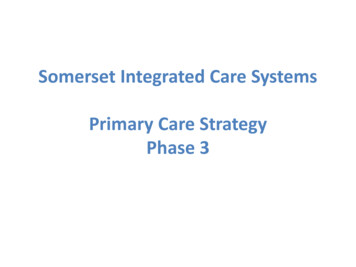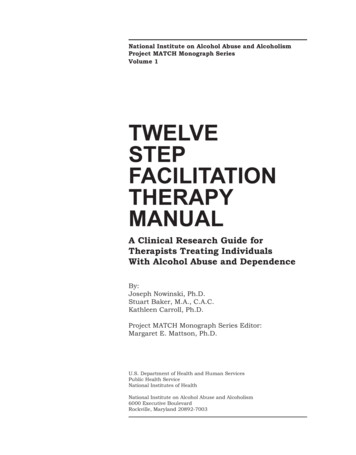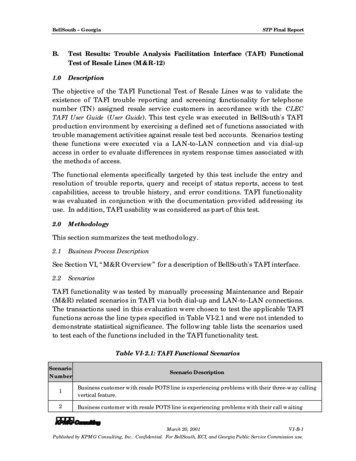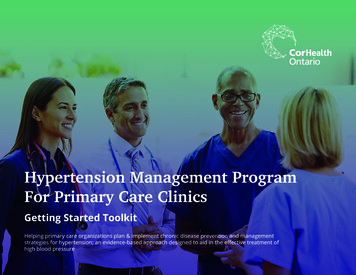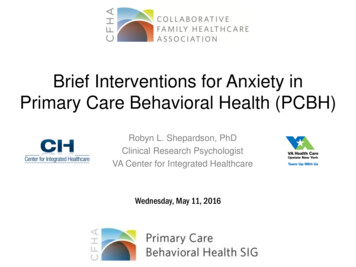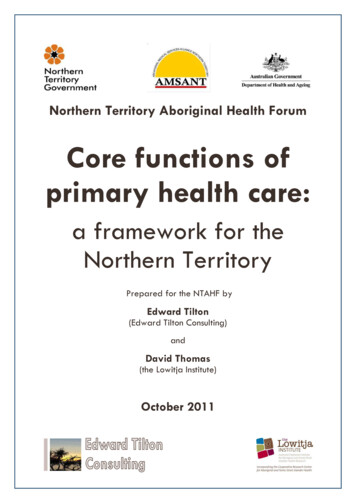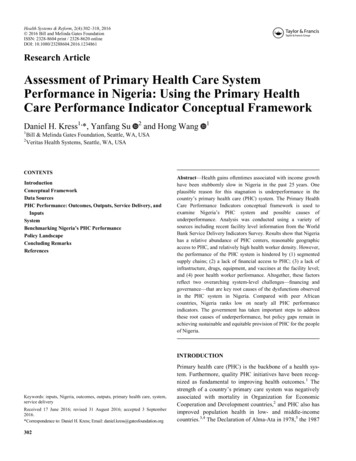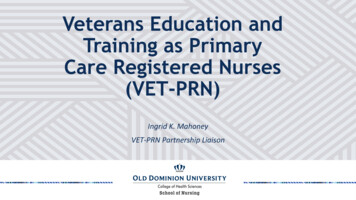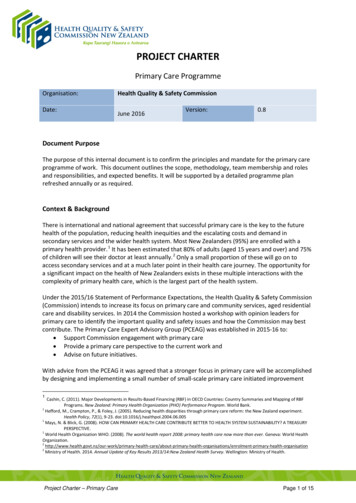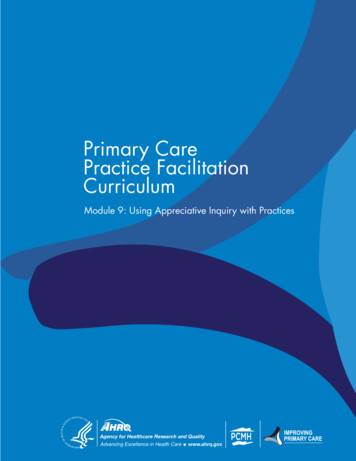
Transcription
Primary CarePractice FacilitationCurriculumModule 9: Using Appreciative Inquiry with PracticesAgency for Healthcare Research and QualityAdvancing Excellence in Health Carewww.ahrq.gov
Primary Care Practice Facilitation CurriculumModule 9. Using Appreciative Inquiry With PracticesPrepared for:Agency for Healthcare Research and QualityU.S. Department of Health and Human Services540 Gaither RoadRockville, MD 20850www.ahrq.govContract No. HHSA2902009000191-Task Order No.6Prepared by:Mathematica Policy ResearchPrinceton, NJProject Director: Deborah PeikesDeputy Project Director: Dana PetersenPrincipal Investigators: Deborah Peikes, Erin Fries Taylor, and Jesse CrossonPrimary AuthorLyndee Knox, PhD, LA Net Community Health Resource NetworkContributing AuthorsCaroline Carter, M.S., L.S.W., Starfish Practice, LLCBeth Sommers, M.P.H., CPHQ, Oregon Rural Practice-based Research Network at OregonHealth & Science UniversityLeAnn Michaels, Oregon Rural Practice-based Research Network at Oregon Health &Science UniversityAHRQ Publication No. 15-0060-EFSeptember 2015
This document is in the public domain and may be used and reprinted without permission exceptthose copyrighted materials that are clearly noted in the document. Further reproduction of thosecopyrighted materials is prohibited without the specific permission of copyright holders.The findings and conclusions in this document are those of the authors, who are responsible forits contents; the findings and conclusions do not necessarily represent the views of AHRQ.Therefore, no statement in this report should be construed as an official position of AHRQ or ofthe U.S. Department of Health and Human Services.Suggested CitationKnox L, Carter C, Sommers B, Michaels L. Primary Care Practice Facilitation Curriculum(Module 9). AHRQ Publication No. 15-0060-EF, Rockville, MD: Agency for HealthcareResearch and Quality; September 2015.Primary Care Practice Facilitation Curriculum MODULE 9M9-ii
ContentsInstructor’s Guide . 1Time .1Objectives .1Exercises and Activities To Complete Before, During, and After the Session .1Module 9 . 3The Basics of Appreciative Inquiry .3Implications of AI for Practice Facilitation .14Summary .14References .15Primary Care Practice Facilitation Curriculum MODULE 9M9-iii
Module 9. Using Appreciative Inquiry With PracticesInstructor’s GuidePractice facilitator (PF) competencies addressed in this module: Basic quality improvement and change management skills Practice assessmentTime Pre-session preparation for learners: 1 hourSession: 2 hoursObjectivesAfter completing this module, learners will be able to:1. Describe how Appreciative Inquiry (AI) differs from the problem-solving approach to qualityimprovement.2. Describe how common facilitation activities are modified when taking an AI approach with apractice.3. Decide when to use an AI approach with a practice.4. Deliver an introductory training to a practice on the AI approach, its methods, and itsassumptions.Exercises and Activities To Complete Before, During, and After theSessionPre-session preparation. Ask the learners to read and watch the following information. (1 hour)1. Module2. Video introduction to Appreciative Inquiry https://www.youtube.com/watch?v ZwGNZ63hj5kDuring the session. Presentation (30 minutes)1. Present key concepts from the module.Discussion. Ask questions and explore answers with learners. (30 minutes)1. How would AI change the way you approach practice assessment? Your use of performancedata? Root cause analysis? Goal setting with the quality improvement team and leadership?2. If you are currently working with a practice, what would you need to modify to implement an AIintervention?3. How likely are you to want to use AI with your practices? What do you like about it? Whatconcerns you?Exercise 1 (30 minutes total)Conduct an Appreciative Inquiry interview. (20 minutes)1. Ask the group to break into pairs and select roles (interviewee or practice facilitator [PF]).2. Provide each pair with a copy of the basic AI interview guide (see table 9.4).3. Ask the PF in each pair to conduct the interview. The AI affirmative topic should be: improvingthis class/course.4. Remind PFs to stimulate in-depth narrative and storytelling during the interview.Discuss the experience. (10 minutes)Primary Care Practice Facilitation Curriculum MODULE 9M9-1
1. Ask pairs to report back to the large group what they learned from conducting the interview.a.b.c.d.e.What lessons did you learn about conducting an AI-focused interview?What was comfortable?What was more difficult?How did this compare to interviews and data collection you’ve done in the past?How do you envision using this with your practices?Exercise 2 (30 minutes total)Have learners practice creating a provocative proposition. (20 minutes)1. Ask learners to break into groups of three-to-five.2. Ask each group to identify someone to play role of facilitator.3. Have each group to create a provocative proposition for their ideal PF training program using theprocess described in this module.4. Ask each group to develop a skit that “acts out” their provocative proposition or to create adrawing that illustrates it.5. Have each group present their skit or drawing to the rest of the class.Discuss the experience. (10 minutes)1. After all skits and drawings have been shared, ask each learner to share one lesson learned aboutworking with a group to create a provocative proposition that they can use in their work withpractices.After the session. Ask the learners to prepare. (2 hours)1. A presentation that they can use to introduce a practice to AI.Optional post-session activities for learnersAI is a complex approach to organizational change that requires more than this module to master. Thereare certification programs available for PFs who would like to develop additional competencies in thisarea. Some places to look include:Case Western tion/certificates/appreciative-inquiryThe Center for Appreciative Appreciative Inquiry efault.cfmPrimary Care Practice Facilitation Curriculum MODULE 9M9-2
Module 9“The significant problems we face cannot be solved at the same level of thinking that createdthem.”—Albert EinsteinAppreciative inquiry (AI) is an approach to organizational improvement that focuses onidentifying organizational strengths and leveraging them to create system-wide change. AIbuilds on the idea of positive deviance or focusing on what is working rather than what is notworking, and on the use of inquiry to drive change. It offers an alternative to traditional,problem-focused models of organizational improvement that start with identifying organizationalproblems and weaknesses, and develop interventions to eliminate the weaknesses.AI emphasizes the important role of questions and language in the change process. It suggeststhat one of the most important roles of a change agent is to construct and ask affirmativequestions. Affirmative questions lead to appreciative discourse and focus organizational work oncollective strengths and desired outcomes. The questions determine how an issue is framed andunderstood, and this information becomes the foundation for the transformation work. If thequestions are poorly formed or hastily considered, the ensuing work may lead to unintended orunhelpful outcomes. If the questions are well formed, and well considered, the ensuing work ismore likely to enhance motivation for change and produce desired goals (Ludema, et al., 2003).This module will introduce you to AI and its primary method, the 4D cycle and suggest waysyou might use it to support practices’ efforts to improve patient care. Knowing the core AIprinciples can broaden your understanding of human organizing and organizational change. Thisenhanced understanding may translate into practical ways of introducing, framing, andmotivating positive organizational change when using a variety of improvement approaches.After completing this module, you should be able to describe AI to a practice and introduceelements of the AI approach into your work with practices. However, this module is not intendedto make you proficient in the use of AI as a practice improvement approach. You will need toconsult the resources mentioned in this module, and obtain additional training to build enoughproficiency to use AI as your primary approach to improvement work.The Basics of Appreciative InquiryAppreciative inquiry has its roots in the positive psychology movement that began in the 1980sand is grounded in “hope theory,” which posits that people are most likely to change when theyhave: (1) an elevating purpose, (2) a sense of collective confidence to accomplish it, and (3) a setof practical steps for moving forward (Hammond, 1998; Ludema, et al., 2003).The key guiding principles of AI (adapted from Whitney and Trosten-Bloom, 2010) include: Dialogue and words form one’s understanding and view of reality.Questions create change.Primary Care Practice Facilitation Curriculum MODULE 9M9-3
What we choose to focus on or study, whether the positive or the negative, will determinewhat we learn.Creating images of the future can guide and inspire action.Positive questions promote positive change.People perform better when given a choice about how and what they contribute.Every organization has at least one thing they do well. Focus on finding this and buildingon this area of “positive deviance.”What the organization pays attention to will increase, so pay attention to areas where theorganization is exceling and seek to expand them.The AI approach was developed by students and faculty from Case Western University as part oftheir work to improve organizational effectiveness at the Cleveland Clinic. Since then, hundredsof organizations around the globe have used AI to improve effectiveness and AI has emerged asa new paradigm for organizational improvement (Carter, et al., 2007; Cooperrider, et al., 2008).Table 9.1 shows how AI compares to traditional problem-focused approaches. The keydifferences between the two are that AI emphasizes identifying organizational strengths andbuilding on them whereas traditional problem-focused approaches stress identifying andaddressing causes of poor performance.AI interventions can involve all members of a practice or organization and focus on system-wideimprovements. Alternatively, they can be used with small groups within a practice, such as thequality improvement team, and focus on more circumscribed changes such as improving diabetescare or patient engagement (Hammond, 1998).You may choose to take an AI approach with all your practices, or you may decide to use AI asan alternative approach for practices in which traditional problem-focused improvement effortshave failed. AI can be particularly helpful in instances in which practice morale is low, theorganizational culture is punitive or not conducive to ongoing quality improvement, or a practicehas failed to improve using traditional problem-solving approaches in the past.Primary Care Practice Facilitation Curriculum MODULE 9M9-4
Table 9.1. Focus of Appreciative Inquiry compared to traditional problem-focusedapproachesProblem FocusedAppreciative InquiryFelt or identified “need” or problemAppreciating the “best of what is”Identifying root causes underlying problemImaging the “possible”Use of quantitative performance data withlimited attention to personal storiesUse of storytelling and personal narrative inaddition to quantitative dataDeveloping solutions to problemsDetermining what “should or could be” andpursuing this; spreading positive deviance toother topics/areasInclusive process involving individuals fromall over practice or small groupInclusive process involving individuals fromall over the practiceAn organization is a problem to be fixedAn organization is an asset to be appreciatedand engagedAdapted from Ludema, et al., 2003. Used with permission.Figure 9.1. AI compared to traditional problem solvingReproduced from: Taylor J. An introduction to Appreciative Inquiry. Rolyat Corp. Red Deer, ntrotoAI.pdfPrimary Care Practice Facilitation Curriculum MODULE 9M9-5
Appreciative Inquiry Process“Appreciative inquiry gets much better results than seeking out and solving problems. Weconcentrate enormous resources on correcting problems but when used continually over along time, this approach leads to a negative culture and a descent into a paralyzing sense ofhopelessness. We can’t ignore problems, we just need to approach them from the other side.”—Thomas H. White, President, Telephone Operations, GTE Wireless(quoted in Ludema, et al., 2003)The first and most critical step in the AI process is to identify the focus for theimprovement work that will be undertaken. In AI terminology, this is called the appreciative (oraffirmative) topic. The appreciative topic must be strategic for practice goals, attractive topractice members and key stakeholders, and motivational and engaging. Examples might be“Revolutionary Customer Response” or “Magnetic Work Environment” or more expansivetopics such as transforming to a patient-centered medical home. Good topics are bold. They are astretch beyond the status quo, they are desired, and they use energizing words (Carter, et al.,2007; Misak and Carter, 2010).The appreciative topic is identified through discussions with practice leadership, staff, and otherkey stakeholders about the organization’s goals and the problems it is experiencing. In a practicesetting, appreciative topics are analogous to goals in more traditional improvement models, butshould be positively worded, compelling, and something that the organization wants to changeand considers a priority (Carter et al., 2007).After the topic is identified, the next step is to develop it into a positive question thatstimulates discussion and reflection. For example, “How can we develop a comprehensivediabetes care program that consistently exceeds quality performance measures and also creates apositive, engaging experience for our patients and staff?” (Carter, et al., 2007).Step 2. Implement the 4D Cycle. The 4D cycle is the main process used in AI. It includes fourphases: discovery, dreaming, designing, and destiny. Figure 9.2 depicts the phases, theirrelationships to each other, and a sample of methods used during each phase. The four phases ofthe 4D cycle can be carried out over the course of an organizational retreat, or during 5 to 10shorter sessions. The AI retreat is the preferred method. The shorter sessions lose momentum andrequire rebuilding the positive energy at each session (Ludema, et al., 2003). The rest of thissection provides a more detailed description of each stage in the cycle and suggests useful toolsyou can use to help your practices move through these stages.Each step of the 4D cycle has a particular focus: Discovery: Determining “best of what is”Dream: Imagining what “could” beDesign: Co-constructing what “should” bePrimary Care Practice Facilitation Curriculum MODULE 9M9-6
Destiny: Empowering, adjusting, innovating to bring the “should” into reality andsustaining itFigure 9.2. The 4D cycle and methodsSource: Carter, et al., 2007; Ludema, et al., 2003. Used with permission.Step 1. Discovery. Discovery is the data collection phase of the 4D cycle. It focuses on a searchfor the “best of what is.” This includes identifying areas of strength for the organization andfactors that energize it (Cooperrider et al., 2008).As a practice facilitator (PF), you can use traditional performance data as part of the discoveryprocess. In these instances, the starting place will be those areas where the practice is performingthe best or shows clear strengths. Root cause analyses of these data (see the Root Cause AnalysisModule 11) would focus on identifying the factors that are contributing to these successes.At the heart of the discovery phase in AI, however, are individual narratives or stories. AIemphasizes that a “narrative-rich” environment is necessary for change to occur. This means anenvironment where storytelling and qualitative information emphasize an understanding of thePrimary Care Practice Facilitation Curriculum MODULE 9M9-7
practice and its goals, instead of just focusing on numeric data. Thus, AI focuses on gatheringcompelling stories from staff and clinicians. These stories help identify the strengths of theorganization as well as the root causes for areas of success. They serve as inspiration forindividuals as they identify changes they would like to make in the organization. They alsoengender hope and energy. An underlying assumption in AI is that good, detailed stories helpparticipants see the possible in what seems to them at the moment to be impossible (Ludema, etal., 2003; Whitney and Trosten-Bloom, 2010).In working with a practice, you can gather these stories through interviews withindividuals from all parts of the organization. Individuals across the organization and keystakeholders can interview each other. It is preferable to interview someone that you do notroutinely interact with or work closely with; for example, a clinician might interview a front deskperson or a medical assistant might interview an administrator.Gathering stories.In the AI framework, the types of questions asked set the direction for everything to follow. Theydetermine what individuals will focus on over the course of the intervention. To be consistentwith the strengths-based approach of AI, questions should be worded affirmatively. The “art” isin crafting effective questions. Well-constructed interview questions stimulate constructivestorytelling from the interviewees, as well as reflection and learning from positive pastexperiences (Cooperrider, et al., 2008; Ludema, et al., 2003).Examples of typical AI discovery questions (adapted from Ludema, et al., 2003; Whitney andTrosten-Bloom, 2010) include: Tell me about your past experiences with this practice. What brought you to work here?What did you like about the organization? Why do you stay? What keeps you showingup day after day?What do you value the most about this practice, the organization, yourself (or your careteam) and the work you are doing here?I’d like you to think back and remember a time when you and your care team wereoperating at your very best. What do you think produced that level of performance? Canyou tell me a story about a particular time your team was functioning at its best? Tell mewith lots of details—like it is a movie script, so I can “see it.”Tell me about what patients experience at your practice. Can you remember a time whenyour team went the extra mile to improve a patient’s experience? Tell me about it. Whatmade this possible? What did you do? What did your team members do? What did othersin the organization do? What other factors in your organization made this possible?Direct observation. Directobservation is
Primary Care Practice Facilitation Curriculum MODULE 9 M9-2 1. Ask pairs to report back to the lar
